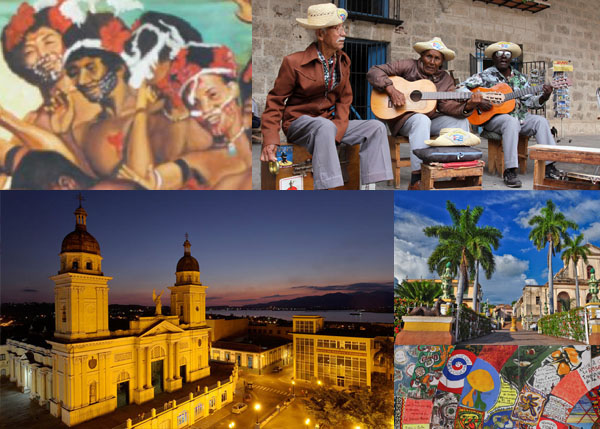10.7.11 Benny Moré’s Giant Band.

Benny Moré founded the musical group known as La Banda Gigante. In order to create his first Banda Gigante, he recruited some of the country’s best instrumentalists, a task that was not difficult given the fame and prestige he had achieved up to that point. The first rehearsals took place in a venue on Calzada de Infanta y Pedroso, in the Cerro neighborhood.
The Giant Band, or the legendary tribe, as they liked to call it, consisted of more than 40 musicians. Its size was comparable only to Xavier Cugat’s big band. Among the former were: Ignacio Cabrera, Cabrerita (pianist and arranger); Miguel Franca, Santiago Peñalver, Roberto Barreto and Virgilio Bizama (saxophones); Alfredo Santiago Chocolate Armenteros, Rigoberto Jiménez and Domingo Corbacho (trumpets); José Miguel (trombone); Alberto Limonta (double bass); Rolando Laserie (drums); Clemente Piquero, Chicho (bongo drums); Tabaquito (tumba player); and Fernando Álvarez and Enrique Benítez (vocalists).
The debut of Benny Moré’s Giant Band was on August 3, 1953, on the popular program “Cascabeles Candado” on CMQ radio. The new orchestra quickly became known throughout Cuba, as the station had a large audience.
The Banda Gigante performed arrangements by musicians such as Ignacio Cabrera (Cabrerita), Pedro Jústiz (Peruchín), and Generoso Jiménez. In these arrangements, Benny captured his desires in terms of rhythm, harmony, and timbre, imbuing his orchestra with the style of the old Cuban son groups.
Their first contract to entertain at dances was in the Spanish Colony, in the town of Placetas, now in the province of Villa Clara. They regularly performed on national radio stations such as CMQ Radio and Radio Progreso; and on television, on Channel 6’s Show del mediodía and Cabaret Regalías. They also appeared in variety shows at the Warner and América theaters (253 Ave. de Italia, Centro Habana, Havana City), among others. They reestablished their recordings with their own record label, and their CDs were released in Haiti, the Dominican Republic, Venezuela, and Cuba.
In 1954, the band began to gain popularity, not only nationally but also internationally. In 1956, they began recording the famous sones montunos dedicated to various Cuban cities, such as “Manzanillo” by Radamés Reyes; “Santiago de Cuba,” “Palma Soriano,” and “Marianao” by Ramón Cabrera; and “Santa Isabel de las Lajas” and “Cienfuegos” by Benny Moré himself.
Beginning in 1956, they embarked on an international tour that lasted until 1957, visiting Venezuela, Jamaica, Haiti, Colombia, and Mexico, where they performed at balls held in major cities such as Caracas, Venezuela, and Cartagena, Barranquilla, and Medellín, Colombia. In the United States, they performed in Hollywood at the Oscars ceremony and later in New York City. During these performances, they shared the stage with renowned artists such as Brazilian vedette Carmen Miranda and Colombian baritone Carlos Ramírez.
At that time, Benny’s orchestra consisted of the following musicians: Lázaro Valdés (pianist); Mauro Gómez, René Aiyón, Fernán Vincent and Diego Loredo (saxophones); Aníbal Martínez, Jorge Varona, Pedro Rodríguez and Pedro Caturla (double bass); Jesús González (drums); Jesús López (tumba player); Enrique Benítez, Gil Ramírez, Delfín Moré and Alfonso Eliseo (singers–choir); and Israel Castellanos (secretary and delegate).
In Havana, they performed in the most famous dance halls, such as La Tropical (Ave. 41, 44, and 46, Playa, Havana City). In 1960, they also began performing at the Night and Day cabaret. They were a constant presence at dances, cabarets, radio, and television. They performed in the black and white clubs of San Juan and Martínez. They traveled to the eastern provinces to perform in Guantánamo, Manzanillo, Santiago de Cuba, Las Tunas, Holguín, and in their beloved towns of Vertientes, Regla, Güira de Melena, and Marianao.
He also performed at the Mambí Salon at Tropicana (4504 72nd Street, Marianao, Havana), and at the “Paper and Ink” parties organized by the newspaper Revolución and held along Havana’s Paseo del Prado, where the country’s best groups and orchestras gathered. He performed at nightclubs such as the Alí Bar Club cabaret (Dolores and Lucero, Arroyo Naranjo, Havana) and the Habana Libre hotel (L and 23rd Street, Vedado, Havana) and the Riviera hotel (Paseo and Malecón, Vedado, Havana). He was a guest of honor at the First Cuban Popular Music Festival, held in 1962 at the Amadeo Roldán Theater (Calzada and D, Vedado, Havana).
On February 16, 1963, Benny performed at a celebration in Palmira, a municipality in the province of Cienfuegos. He had to return to Havana due to his illness. Benny Moré died on February 19, 1963, and with him, his beloved Banda Gigante disappeared.








